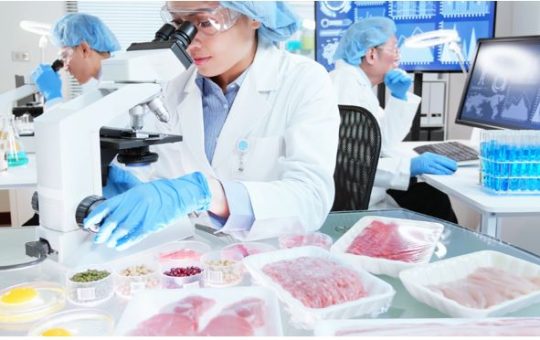
Level 2: Intermediate Food Safety and Hygiene Practices
Course Overview:
The Level 2: Intermediate Food Safety and Hygiene Practices course is designed for individuals who work in food handling or food preparation environments, including food service, catering, and retail sectors. This course provides an in-depth understanding of food safety principles, hygiene practices, and the importance of maintaining high standards to prevent foodborne illnesses. It is particularly useful for supervisors, team leaders, and those responsible for ensuring food safety in their workplace. The course focuses on understanding risks related to food safety, applying hygiene practices, and maintaining a clean, safe food environment for both employees and customers.
Why Take This Course?
- Enhance Your Food Safety Knowledge: Build on your basic understanding of food safety and hygiene, and learn how to implement more advanced practices.
- Practical Application: Learn how to manage food safety hazards in a variety of food handling and preparation environments.
- Comply with Regulations: Ensure that your workplace meets food safety regulations and standards, keeping customers safe and your business compliant.
- Career Advancement: Completing this course opens opportunities for supervisory roles in food safety, quality assurance, and food management.
Learning Outcomes:
Upon successful completion of the course, you will be able to:
- Recognize the key risks associated with food safety and hygiene.
- Apply good hygiene practices to minimize the risk of food contamination.
- Understand the role of temperature control in food safety, including safe food storage, preparation, and serving practices.
- Demonstrate the ability to identify and prevent common food safety hazards, such as cross-contamination, poor hygiene, and unsafe food handling.
- Understand the importance of cleaning and sanitizing food contact surfaces to maintain a hygienic environment.
- Implement food safety policies effectively in your workplace.
Course Content:
- Introduction to Food Safety and Hygiene
- Learn the key principles of food safety and why hygiene practices are critical in preventing foodborne illness.
- Understand the impact of poor hygiene practices on food safety and public health.
- Foodborne Illness and Its Causes
- Explore the common causes of foodborne illnesses, including harmful bacteria, viruses, and parasites.
- Learn about the signs and symptoms of foodborne illnesses, and how to prevent outbreaks through proper hygiene and handling.
- Personal Hygiene Practices
- Study the importance of personal hygiene for food handlers, including handwashing, appropriate attire, and protective measures.
- Understand how to minimize the risk of contamination from food handlers to food.
- Safe Food Handling Practices
- Learn safe food handling techniques, including thawing, preparing, cooking, and serving food to prevent contamination.
- Understand the concept of cross-contamination and how to avoid it in the workplace.
- Temperature Control and Storage
- Understand the role of temperature in food safety, including safe food storage, preparation, and serving temperatures.
- Learn how to monitor and maintain temperature control to ensure food is kept at safe levels to prevent foodborne illness.
- Cleaning and Sanitizing
- Study the importance of cleaning and sanitizing food contact surfaces, equipment, and utensils.
- Learn how to properly clean and sanitize areas in the food preparation environment to reduce the risk of contamination.
- Food Safety Regulations and Compliance
- Gain insight into food safety regulations and best practices to ensure compliance with local and international food safety standards.
- Learn how to implement and monitor food safety practices to meet regulatory requirements.
Career Progression:
After completing the Level 2 Intermediate Food Safety and Hygiene Practices course, you will be equipped to take on key roles within food safety and hygiene management, including:
- Food Safety Supervisor: Oversee food handling and hygiene practices in a food establishment, ensuring compliance with food safety standards.
- Catering Manager: Manage food safety protocols within a catering environment, ensuring hygiene standards are met during food preparation, service, and delivery.
- Quality Control Officer: Monitor food safety practices, ensuring that hygiene standards are consistently followed in food processing and preparation.
- Food Hygiene Consultant: Advise food businesses on improving their food safety and hygiene practices to meet regulatory standards and reduce risks.
Our assessment process is designed to ensure every learner achieves the required level of knowledge, skills, and understanding outlined in each course unit.
Purpose of Assessment
Assessment helps measure how well a learner has met the learning outcomes. It ensures consistency, quality, and fairness across all learners.
What Learners Need to Do
Learners must provide clear evidence that shows they have met all the learning outcomes and assessment criteria for each unit. This evidence can take different forms depending on the course and type of learning.
Types of Acceptable Evidence
Assignments, reports, or projects
Worksheets or written tasks
Portfolios of practical work
Answers to oral or written questions
Test or exam papers
Understanding the Structure
Learning outcomes explain what learners should know, understand, or be able to do.
Assessment criteria set the standard learners must meet to achieve each learning outcome.
Assessment Guidelines
All assessment must be authentic, current, and relevant to the unit.
Evidence must match each assessment criterion clearly.
Plagiarism or copied work is not accepted.
All learners must complete assessments within the given timelines.
Where applicable, assessments may be reviewed or verified by internal or external quality assurers.
Full learning outcomes and assessment criteria for each qualification are available from page 8 of the course handbook.
Top Courses
No results found.
Related Courses
Let's Get in touch
Deleting Course Review
Course Access
This course is password protected. To access it please enter your password below:



